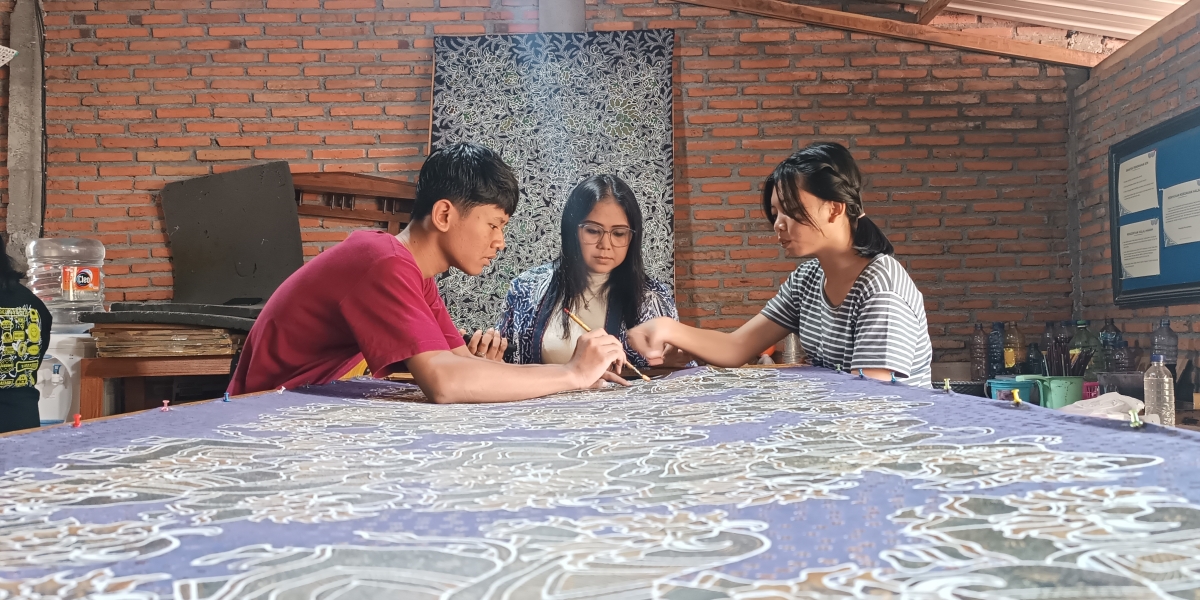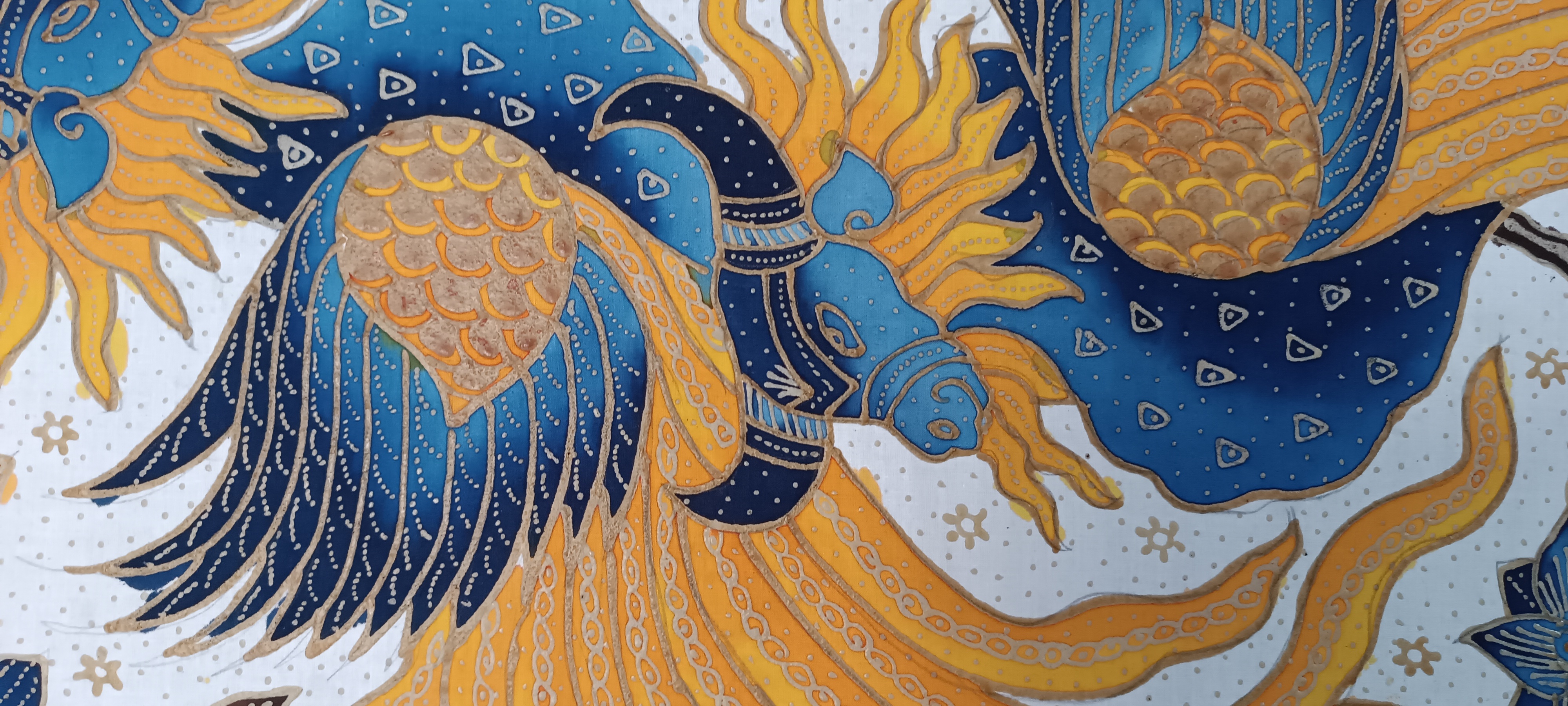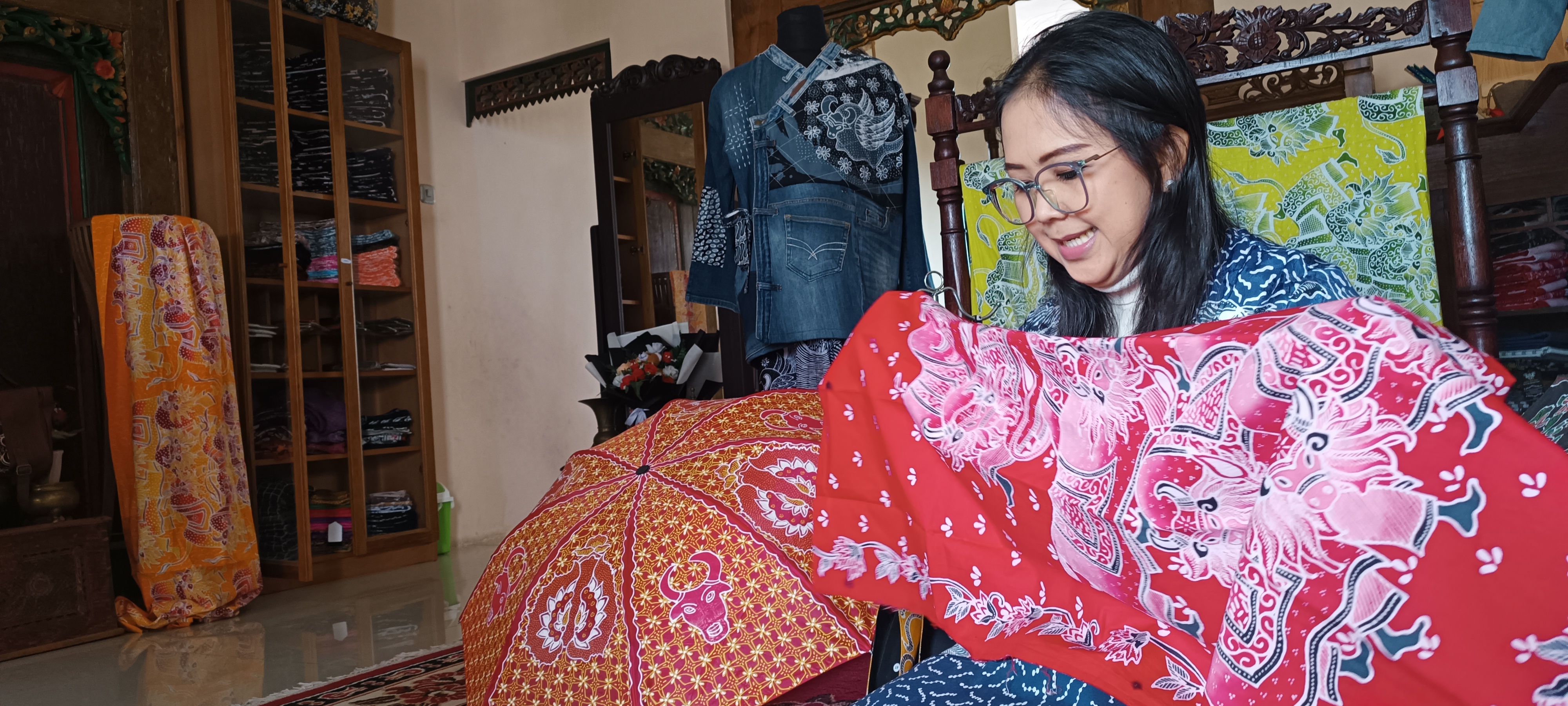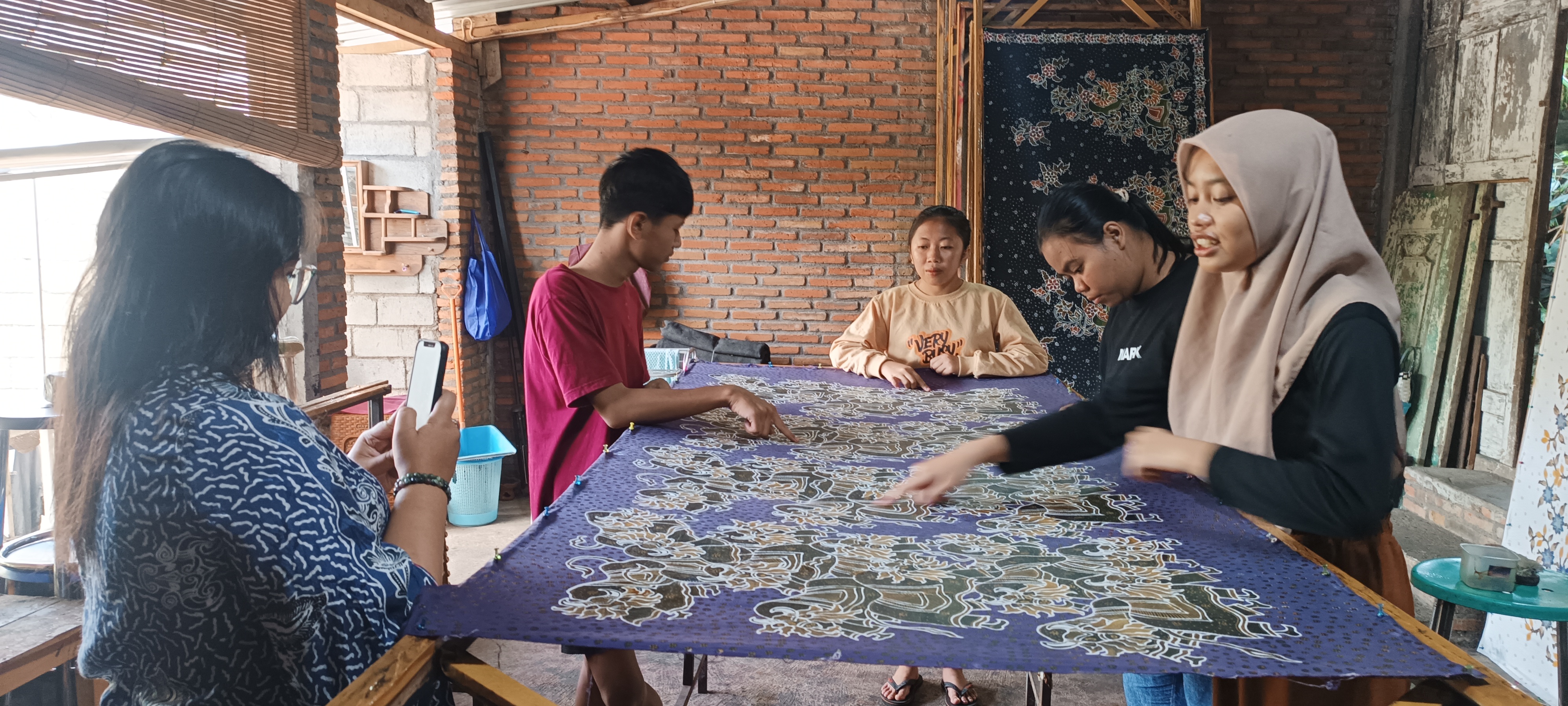Heartbreaking to See the Suffering of Palestinian Children, Dimas Seto Invites Prayers and Donates
Dimas Seto is one of the Indonesian celebrities who is concerned about the escalating Israel-Palestine conflict. Read the complete information!

Kapanlagi.com - Reporter: Darmadi Sasongko
Anjani Sekar Arum (33) introduces the traditional art of Bantengan through her batik creations. The Bantengan motif becomes a distinctive characteristic and a means to introduce the unique cultural art of Kota Batu to the public.
More than 2,000 batik motifs have been produced by Anjani under the brand name Batik Banteng Agung. All of her works feature the main motif of a bull's head.
"There is always a bull's head, seven types of flowers, incense, benzoin, charcoal, musical instruments, and a whip. We incorporate all of these elements into the batik. So if there is no bull's head, usually seven types of flowers or other motifs are depicted," explained Anjani to merdeka.com at her gallery complex in Dusun Binangun, Desa Bumiaji, Kecamatan Bumiaji, Kota Batu, on Monday (23/10).
Bantengan itself is a traditional dance art accompanied by lively jaranan music. This dance specifically uses several props, including a bull's head made of wood. There are two dancers in Bantengan, each positioned at the head and tail (front and back).
The dancers inside the Bantengan will sway and move to the rhythm of jaranan, accompanied by the sound of a whip. The Bantengan dancers are usually in a trance state.

Anjani Sekar Arum (Photo Credit: KapanLagi.com/Darmadi Sasongko)
Bantengan art is popular in East Java, including in Batu, Malang, Mojokerto and the surrounding areas, highlighting their respective characteristics. Thousands of Bantengan art groups are estimated to exist and thrive in the villages in the region up to the present time.
"One of its missions is indeed to introduce Bantengan culture. So that it continues to be known because people will surely ask, what does the Bantengan head mean, from there we promote Bantengan culture," she said.
Anjani herself grew up in an artistic family environment before later engaging in painting and batik entrepreneurship. Her father is Agus Tobron Riyanto, an artist community activist in Batu City.
Since childhood, Bantengan art has been a regular spectacle and always eagerly awaited, especially during carnivals. Therefore, Bantengan art has become something ingrained in her life.
"My grandfather (her father's father) was a Bantengan warrior. Then it was passed down to my father, the founder of the Nuswantara cultural community. My father has developed various arts including Bantengan. During carnivals, the Bantengan group is always the most anticipated, bumping here and there. So it's the favorite culture of Batu City, including mine," she said.

Anjani's Bantengan Batik artwork (Photo Credit: KapanLagi.com/Darmadi Sasongko)
Initially, Anjani focused on painting, even her college major was in the Department of Art, Faculty of Literature, State University of Malang (UM). Meanwhile, she began to seriously explore and engage in batik art around the 6th semester.
Her batik works were published in 2014, at the same time Bantengan was patented as the Cultural Art of Batu City. At that time, all of her works were more focused on artistic creations, and she had not yet thought of turning it into a business.
"Initially, I only had solo exhibitions of my batik works from 2010 to 2014. There was no intention to sell," she said.
At that time, Anjani only created various batik motifs for artistic purposes. But the process was continuously accompanied by innovation in terms of the banteng motif, ornaments, shapes, and even the production techniques. As a result, there was always innovation, especially driven by the desire to make Bantengan a distinctive batik motif of Batu City.
"Then many customers wanted to have our batik, with the distinctive Bantengan motif that may only exist with us. Because Bantengan art is only found in East Java, especially in Batu City, we continue to produce that motif," she explained.
Arjani's Bantengan Batik motifs are mostly produced individually, although more than 2000 types of motifs have been created during her involvement in the batik world.
"Usually, once it is sold out, we immediately create a new one, instead of continuously producing the same motif. Already sold out, let's make a new one. Each fabric has a different design, there are flying bantengan batik and bantengan with legs. Some of them are just taking the ornament of the bantengan head, then we apply it to other animals, birds. So it's not always the bantengan head," he explained.

Anjani Sekar Arum (Photo Credit: KapanLagi.com/Darmadi Sasongko)
Batik Bantengan has now been patented as the distinctive Batik of Kota Batu. Arjani's work has also reached the international market. Batik exhibitions, both local, national, and international, have been participated in, including in Australia, Malaysia, Singapore, Taiwan, Prague (Czech Republic), India, and others.
In addition to hand-drawn batik, Anjani also produces stamped batik with Bantengan motifs. She also combines various materials, including recycled materials, to meet the demand of the Japanese market.
"We have sales to Japan, and recently we signed an MOU with India. They buy our clothes in bulk, then open boutiques in India," she said.
Stamped batik is sold at a price of Rp200,000, while hand-drawn stamped batik is sold at a price range of Rp300,000 - 500,000. Meanwhile, hand-drawn batik is priced from Rp450,000 to Rp18 million.
Anjani's monthly production reaches 250 pieces with a sales figure of around 75 percent. This number does not include the 3,000 pieces of stamped batik she produces per month.

Anjani Sekar Arum (Photo Credit: KapanLagi.com/Darmadi Sasongko)
The motif of the Bull in Anjani's Bantengan batik is not unrelated to the issues and atmosphere of the political year. Although the Bantengan Batik motif refers to Bantengan art, and not the symbol of a political party. This includes when an institution buys his batik, they think twice when wearing it as a uniform.
"If in 2023 it might become our business field. But now, the political year is very sensitive, especially among civil servants and officials. When they order batik with the Bantengan motif, they are afraid, thinking that it supports a certain political party," he said.
Although in reality, the Bantengan Batik is not the same as the symbol of a particular political party. But the Bantengan motif, even though it is equipped with wings and different colors, is still often considered to be associated with a certain party.
"Our batik is clearly Bantengan, the cultural art of Kota Batu has nothing to do with political parties," he said firmly with a smile.
Therefore, Anjani does not stop explaining and convincing customers that his work is not from a particular party. On the contrary, his work aims to preserve the Bantengan art and prevent it from becoming extinct.
"We are only raising our heads, and even the head is not the same as the head of a political party's logo. That's us in the political year," he said.

Anjani Sekar Arum (Photo Credit: KapanLagi.com/Darmadi Sasongko)
Through her studio and gallery, Anjani preserves the art of Batengan and Batik. Her studio serves as a place for young people to learn about batik. Everyday, children and students line up for the opportunity to learn in her workshop gallery.
Anjani and her team train young children in batik, some of whom receive the training for free. This education is provided as part of her efforts to preserve the art of batik and the art of Bantengan.
"I cannot separate myself from the world of education. For 6 years, I was a Cultural Arts teacher at SMP 1 Batu. Since resigning in 2018, I remain committed to the world of education, teaching batik," she said.
Anjani's gallery is also enriched as an educational batik tourism location. As a result, her studio and gallery have become educational tourist destinations in the city of Batu.
In addition, the gallery also provides employment for dozens of local workers. They bring the work home and return it during the coloring stage.
Because of that spirit, Anjani was once awarded as a Young Entrepreneur by the Ministry of Education and Culture (2018). She has won the Young Entrepreneurship Awards from Bank BUMN in 2018 and 2019 consecutively, and also received the Anugerah Satu Indonesia Awards 2017 from PT Astra International Tbk.
"So how can we introduce culture through a product that everyone uses, and ask why Bantengan batik, what are its distinctive features? With people asking, there will be a lot of knowledge," she said.
Anjani is also the Founder of the Indonesian Little Batik Community. The community has gradually been established in several cities, including Batu, Yogyakarta, Singkawang, and continues to strengthen its network.
"I want to create the Indonesian Little Batik Community from Sabang to Merauke, that's the dream I'm pursuing. Later, I want to create it in IKN (Capital City of Nusantara), I want batik to be there too," she said.
For Anjani, children are the future generation who will inherit art and culture. They must be prepared to become the guardians of heritage in the future, including Bantengan and Batik art.
(kpl/dar/gtr)
Cobain For You Page (FYP) Yang kamu suka ada di sini,
lihat isinya
Dimas Seto is one of the Indonesian celebrities who is concerned about the escalating Israel-Palestine conflict. Read the complete information!
One of them is the world model Gigi Hadid who also pays attention to the battle between the two countries. The former girlfriend of Zayn Malik asserts her support for Palestine.
Shocking news came from Vadel, the boyfriend of Lolly, Nikita Mirzani's child. He has been designated as a suspect in the beating of a babinsa member. Read the complete information!
Bojes AFI lost his father forever. Check out the portraits of him crying while accompanying his father at the funeral below!
The cyanide coffee case involving Jessica Wongso is currently making headlines due to the film ICE COLD. Many parties related to the case have spoken up, including Jessica's lawyer, Otto Hasibuan. Read the complete information below!
Ayu Ting Ting shares a moment with her beloved child when she prepares supplies. Check out the complete information!
Pyo Ye Rim, known to the public as a YouTuber and bullying victim at school, passed away at the age of 27.
Gal Gadot affirms support for Israel.
Azizah Salsha is currently being talked about, as she recently celebrated her 20th birthday in a grand manner. Although attended by many of Azizah's friends, her waist tattoo became the highlight, why is that?
There is a luxurious house resembling a palace located in Sidoarjo. Check out the detailed portraits of the house below!
After previously saying he won't clarify, Valdi Ghifari finally apologizes.
Denny Caknan flooded with netizen comments because of his content that includes kicking Bella Bonita.